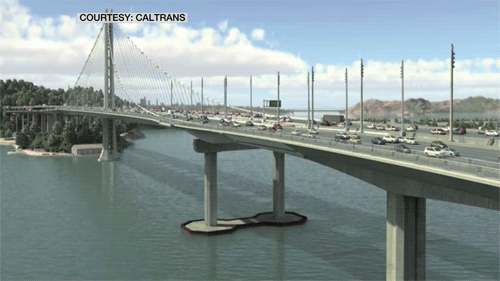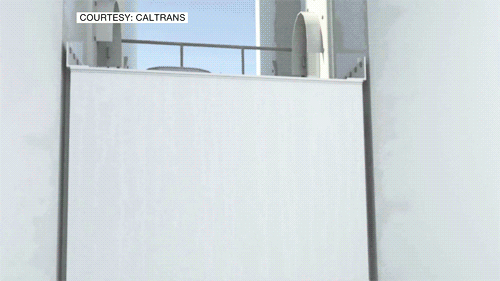Producer’s Blog: California dreaming for an earthquake-safe future
Growing up in Southern California, there was one thing we always practiced that kids in other parts of the country didn’t have to worry about: What to do in case of an earthquake.
In the 1980s we all feared “The Big One.” It seemed like every week there were news reports of a monster earthquake that was absolutely, positively going to strike “within the next 20 years.” In grade school we practiced earthquake drills every year. In the middle of a lesson, we would be told to DROP!!! We were then instructed to crouch beneath our desks, and wait there in our “duck and cover” positions until the all clear was given.
I remember the Loma Prieta quake in late 1989. It was early evening, and I was watching the World Series, which that night was in San Francisco’s Candlestick Park. When the earthquake struck, everything came to a grinding halt, including the baseball game, which was postponed. Like all Californians, I was glued to the news reports and watched as a section of the Bay Bridge collapsed on live television. It was a horrific scene, which suddenly had me worried about something I had never thought about prior to that quake: Will all large structures fail and ultimately fall in a big quake?
The 1994 Northridge earthquake hit Southern California’s San Fernando Valley when I was a journalism student at the University of Missouri. After calling family and friends, I found myself watching the endless coverage on the news. Seeing so many collapsed buildings and buckled highways was frightening and left me with the sense that no one was safe in earthquake country. Quakes always come without warning and can seemingly strike anywhere.
My family was fine, but our home suffered some serious damage. Like many of our neighbors and friends, our chimney collapsed and had to be rebuilt. All things considered, this was a minor fix compared to those people who escaped as their homes fell to the ground. But Angelinos recovered and began again. Homes were rebuilt, as were the buckled highways and roads. Still, I often think about the buildings in Los Angeles, as we are still waiting for that “big one” to hit, and I wonder which structures will survive and which will suffer colossal failures.
There are always reports and stories about how engineers are making buildings “earthquake safe,” which often involves the retrofitting of older buildings. Newer structures are built with earthquakes in mind, so I presumed that the soundness of structures in Los Angeles are considered fixed. But my latest assignment on seismic innovations changed everything I thought I knew about earthquake safety.
The new stretch of the San Francisco-Oakland Bay Bridge is spectacular. It is a magnificent bridge and quite a sight to see. But it is its safety and strength that make it a bridge like no other.
After the 1989 quake brought down a section, the bridge was ultimately fixed, and life went on. However, while working on this story I learned that there was still a tremendous amount of fear that the bridge still was not sound. Imagine driving that bridge every day for nearly 25 years and not knowing if it was a truly safe road to travel. Lots of the people I met spoke about how they couldn’t wait “to get to the tunnel” and out of harm’s way. It was a daily, quiet terror for many commuters as they crossed the bridge, hoping to make it to the other side before the next quake, which would surely pitch them into the bay.
Mark Teague
TechKnow Producer
Now the new $6.4 billion bridge span is open for business, and this mammoth bridge was created with safety as its most important design aspect. The seismic innovations on the bridge are impressive, clever and futuristic.
More About This Story
Crumple technology, used in cars to protect passengers, is the latest to be employed on the new bridge. In a crash, automobiles can crumple like a soda can all around the occupants while preserving the cabin. Furthermore, on the bridge, the shear link beams and hinge pipe beams are designed to fail; the beams allow the bridge to bend, but not break. This is genius. The beams are the weakest parts of the bridge. But by rocking and deforming, they allow the rest of the bridge to stay intact. After an earthquake, engineers can inspect the damage and then replace the broken parts without the worry of total collapse.

The battered piles hold up the bridge and allow for movement during a large, seismic event. They are drilled into the bottom of the bay, 300 feet down, under many layers of mud and rest at angles as opposed to being simple vertical. Under the old bridge, the piles in the water only descended 200 feet, and they stood upright. The idea of using the angled battered piles comes from how off-shore oil rigs are constructed. This is the technology that keeps those oil rig platforms in their place way out in the open ocean.

The most exciting innovations are the rocking frames, which use the same crumple zone technology found in cars. During an earthquake, the frames rock back and forth and allow the building to give a little without falling down.

So, why doesn’t everyone build with these innovations? The simple answer: Cost. It is more expensive to build these frames into structures. However, once engineers figure out how to drive the cost down and mass produce them, it is likely that many more builders will invest in such important building advances.
We had the opportunity to experience a rocking frame in action at the City Hall in Orinda, Calif. Indeed, we felt safer there than in our hotel in San Francisco.
I wouldn’t mind traveling across the new Bay Bridge during a large earthquake. I’d rather not. But—if I had to—it would be an extremely safe place to ride out a quake.
To learn more about the engineering innovations on the new Bay Bridge, watch "TechKnow," Sunday 7:30ET/4:30PT.
Error
Sorry, your comment was not saved due to a technical problem. Please try again later or using a different browser.